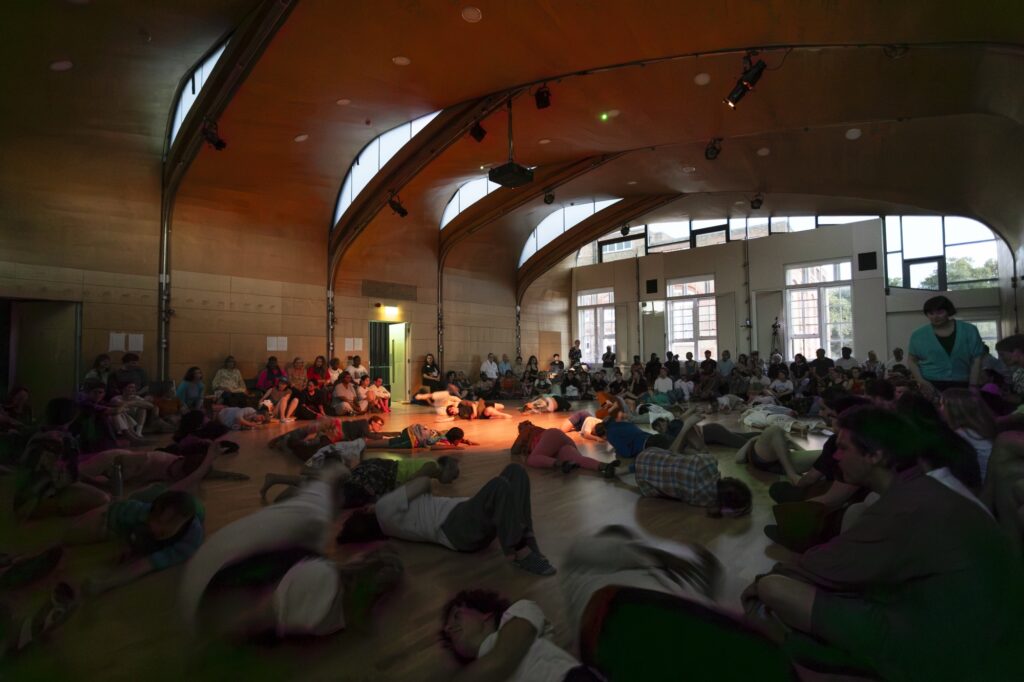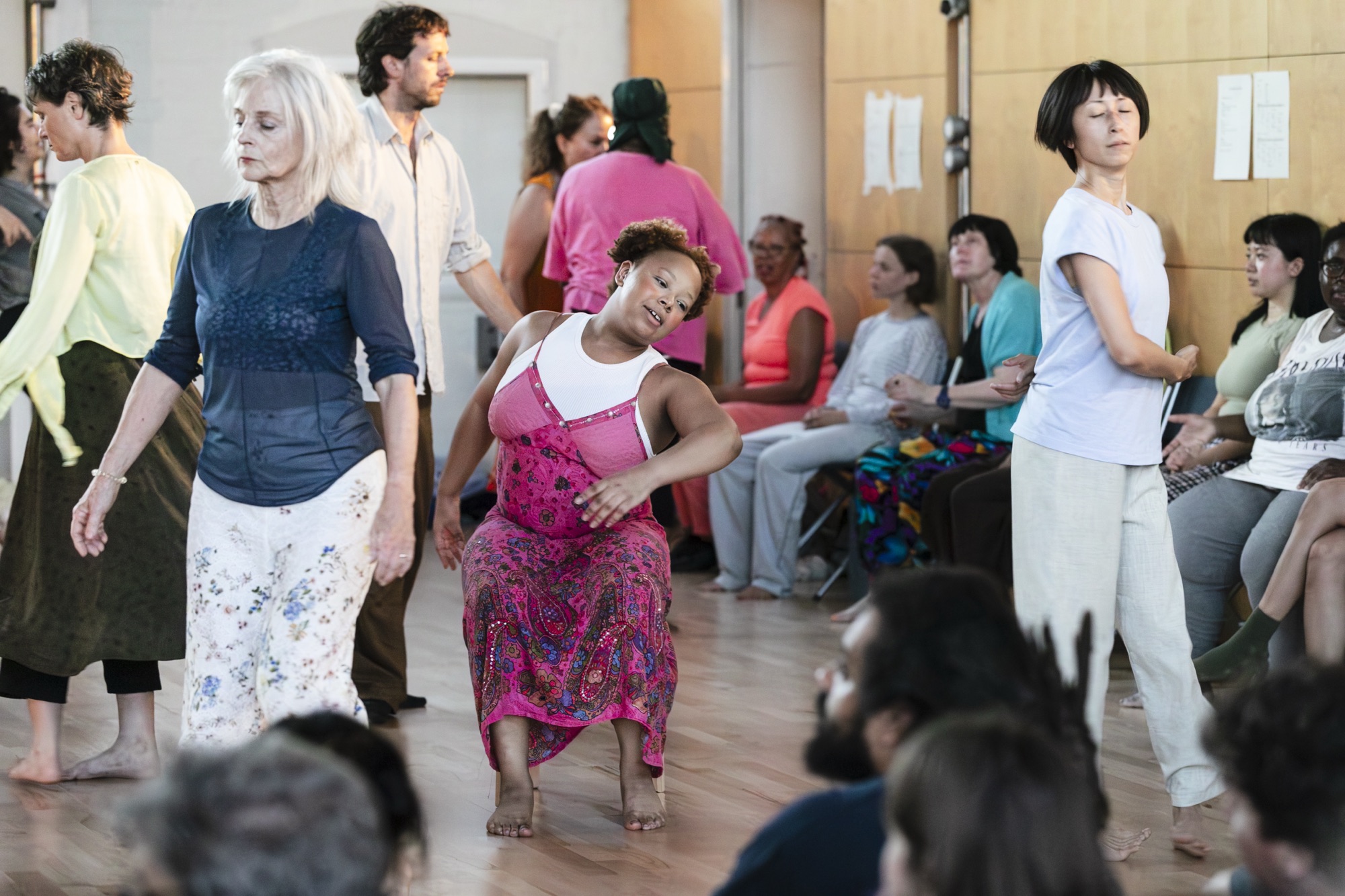Words by Lydia Wharf.
I’ll start with a disclaimer – they had me at the mention of ‘dawn’.
Whilst I realise that it’s not everyone’s cup of tea, there’s something genuinely exciting about the notion of setting the alarm for 3am, travelling to Siobhan Davies Studios in the dark hum of early morning and watching a dance performance event that takes place as the sun rises, between 4 and 5. It’s a simple concept that feels quite radical; challenging notions of normative theatre practice, perhaps an indicator of gentle resistance? Whatever its rationale, the practical outcome is that travelling to the venue might feel uncomfortable (am I really up at 3am?!) but overwhelmingly it’s exciting – the prelude to adventure. Rather than the shoulder-to-shoulder of sweaty, fluorescent peak time travel there are empty, silent streets, foxes startled in pools of streetlight, the odd reveller stumbling home to bed, a world seen differently through sleepy eyes.
EMOTION is the fourth iteration of an annual community performance project offered by SDS, following LANGUAGE, POWER and FEAR, each directed by Annie Pui Ling Lok and Juan Ayala. Its 68-strong cast (!) have assembled for 8 workshops to co-create this new work, exploring performance as a communal act.

A hushed bustle greets me on arrival at SDS; the event is sold out and the building feels enjoyably full and expectant. After gathering around a coffee station, the audience files obediently through the building to an expanse of outdoor space – this is the playground of the recently-closed Charlotte Sharman School. From here, the performance begins in the dimness of pre-dawn. Emerging gently from our midst are the participatory cast of EMOTION who identify themselves by sporadically clapping their hands, letting us know that something is taking shape. Delineation of roles is felt through the steady, purposeful pacing of those performing and the quiet wonder of those watching. It’s a large cast but there’s a sense of intimacy in the pleasantly blurry line between audience and performer; the occasional warmth of eye contact feels personal and welcoming. Graceful movements greet the first signs of approaching light, summoning the day in a soft ritual that sweeps across the space. But before glimmers of dawn can take hold, we follow prompts to leave the playground behind and move back inside the building where the audience assembles around the edges of the lovely, wooden arcs of the Roof Studio.
Performers steadily enter, rolling and slithering in through the doorway lengthways, pushing themselves gradually into the space, filling the centre of it completely, an unfolding mass of soft bodies shifting and adjusting to each other. Gradually, slowly, they rise to hands and knees and eventually to their feet. Murmuring becomes soft voices becomes singing; the group builds momentum and volume, becoming highly charged. The swell of energy and speed is suffused with the detail of 68 differently abled, aged and sized bodies filling the space, a constantly-evolving choreography of characteristics. The performers don’t move ‘as one’ but they are very much together, and this unification feels powerful.
A physical shift as the audience is invited to gather end-on rather than ‘in the round’ heralds an energetic change; performers now break away into smaller groups, solo sections and inter-actions. Dancing to their own tune, individual performers come into sharper focus – interpretive, expressive, perhaps more EMOTIONal. There’s a recurring tug of war, a queue, a little routine with a rhythm all its own, which spreads across the dancefloor until everyone joins in, accompanied by a thudding beat. It becomes possible to ‘know’ the individuals, catching their quirks and habits, recognising a particular physicality or energy. I remember Boris Charmatz’ Musee de la Dance, which was presented at the Tate Modern some 10 years ago, perhaps the first time that I’d witnessed a large cast of ‘non-professional’ dancers. Although the memory is somewhat hazy, I was struck by the presentation of these tender, ‘ordinary’ bodies on stage, as opposed to the more familiar extra-ordinary bodies of trained dancers. Their vulnerability was utterly disarming, offering a glimpse of rich and personal history through tiny details – a scar, a limp, an expression. EMOTION invokes similar feelings; the multitudinousness of its cast is not a ‘blank canvas’ for the choreographer but a rich, colourful tapestry.
Framing people as ‘performers’ is inherently exposing; lit, staged and choreographed, they are presented to an audience for consideration. EMOTION asks; ‘why we perform, for who and to what end?’ Watching this community of people performing together, I ask the same question; what might drive so many people to commit to rehearsals, to a team, to a public event? For professionally trained dancers too, who are here in this mix. It’s certainly not financial reward and, although we’re promised a breakfast, I don’t think it’s that either. Could this appetite for coming together in a process of co-creation satisfy something more fundamental? Something that’s borne of wider society, in this quite particular moment of widespread polarisation, loneliness and isolation? A Covid hangover. A by-product of rampant capitalism. Is dancing together the antithesis of those ills? The remedy?
Time is one thing, place is another. The curation of an annual participatory experience in this building from 2022- 2025 is not a coincidence. SDS is located in a part of London so radically changed by relentless gentrification that the school whose playground we began in is being closed, due in part to the long-term decline in pupil numbers, driven by demographic shifts and the cost of living. Once an area rich in cultural diversity, within which community and culture were firmly rooted, Elephant & Castle is largely unrecognisable; the interests of commercial developers are king, much else is lost. Coming together as a community to celebrate difference, to create an inclusive celebration in this place and time is a radical act, a joyful dance of resistance. The breakfast tastes all the better for it.
